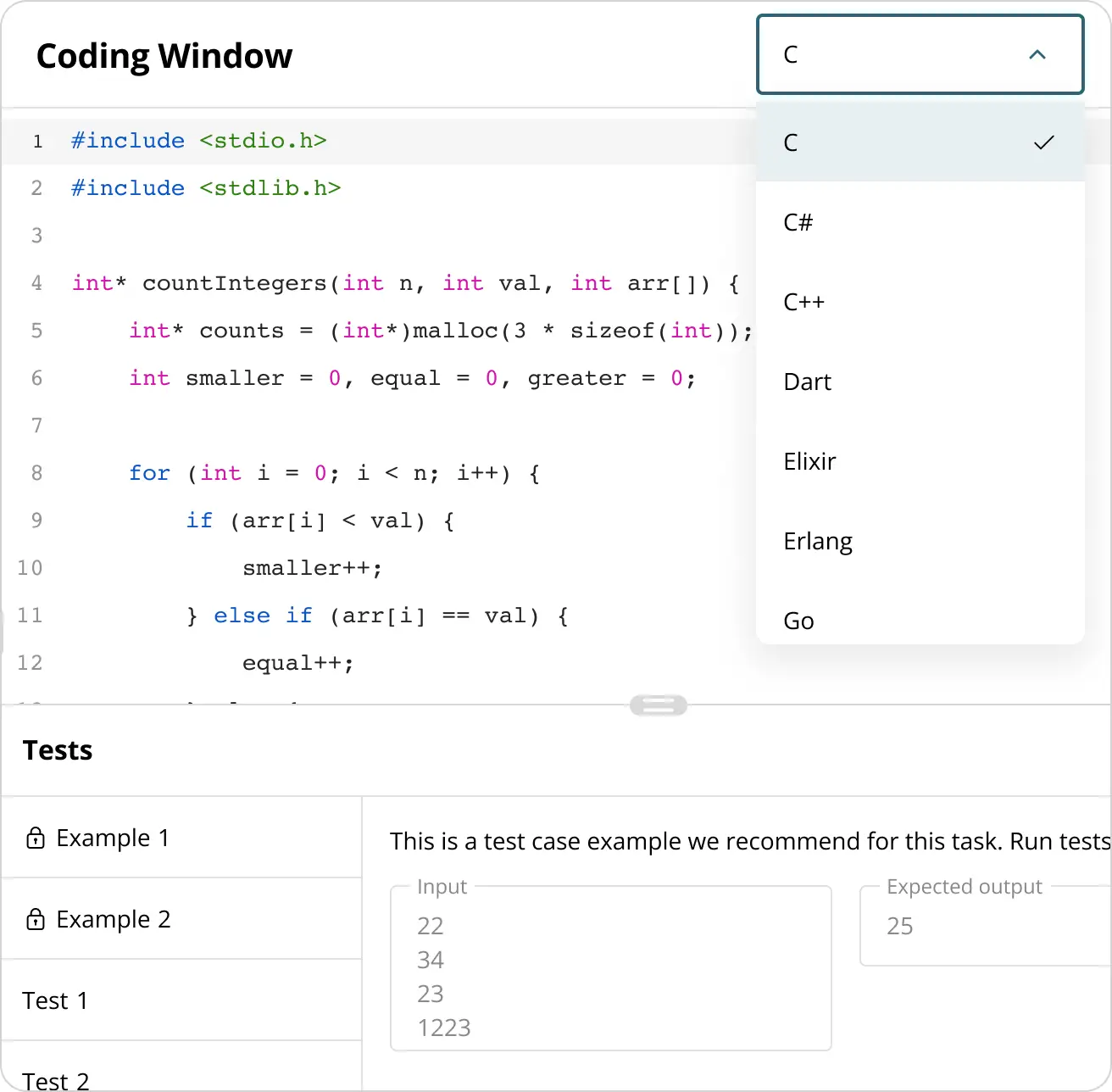Universal coding tests
Why limit talent with single-language coding tests? Test 12 essential programming skills in universal coding tests that cover up to 20 languages.
Select from an array of expert-designed challenges covering algorithmic thinking, debugging, and data structures to find your most adaptable and innovative developers.
Test coding skills in any of these programming languages
JAVASCRIPT
Fluency in JavaScript is a telltale sign of a developer's skills in front-end development, user interface manipulation, and interactivity.
JAVA
A strong grasp of Java is a valuable asset for engineers creating enterprise software, web applications, and Android apps.
PYTHON
Python's readability makes it a great way to identify developers with strong problem-solving skills and potential for growth in programming.
PHP
Assessing expertise in PHP can help you identify a developer's core web development abilities, including scripting, debugging, and optimization.
C
C is a foundational language that demonstrates a developer’s ability to write efficient, low-level code and build system-level applications.
C#
A solid grasp of C# is a great indicator of a developer's capabilities in building Windows applications and enterprise software.
C++
A strong grasp of C++ is a valuable asset for engineers creating game engines, operating systems, and performance-critical software.
KOTLIN
Adding the Kotlin language to your test allows programmers to showcase their skills that could translate to building cross-platform applications.
RUBY
With Ruby, developers can showcase their ability to create web applications quickly and efficiently using Ruby on Rails.
TYPESCRIPT
A strong grasp of TypeScript is a valuable asset for developers working on complex, large-scale JavaScript applications.
GO
Go is a valuable asset for developers working with cloud-native applications, scalable microservices, and high-performance systems.
R
A strong grasp of R is a valuable asset for engineers working in data science, bioinformatics, and other fields that rely heavily on statistical computing.
SCALA
Scala allows developers to build web services, data pipelines, machine learning models, and reactive systems. Its mix of functional and object-oriented programming enables scalable, high-performance development.
SWIFT
Swift helps developers build modern iOS, iPadOS, macOS, watchOS, and tvOS apps. Proficiency in Swift ensures efficient, high-performance development using Apple’s intuitive programming language.
PERL
A strong grasp of Perl is a valuable asset for developers maintaining legacy systems, writing configuration scripts, and automating system administration tasks. It also supports efficient text processing and data manipulation across various applications.
DART
Proficiency in Dart highlights an engineer’s ability to build user interfaces and manage application logic within the Flutter framework. This skill enables the development of fast, cross-platform applications for mobile, web, and desktop.
JULIA
With the Julia programming language, candidates working on simulations, data analysis, machine learning, or other computationally intensive tasks can showcase their skills.
RUST
A strong grasp of Rust is a valuable asset for developers creating reliable, performant embedded systems, operating systems components, and high-concurrency applications.
ELIXIR
With Elixir, programmers with skills in functional programming, building scalable and fault-tolerant systems, and concurrency handling can effectively showcase their ability.
ERLANG
Proficiency in Erlang showcases a developer's ability to design and build robust, distributed systems that prioritize uptime and efficient handling of concurrent processes.
Test 12 programming skills in up to 20 coding languages
Let candidates showcase their problem-solving skills and coding expertise in the language they know best—because adaptability and logic matter just as much as syntax.
Coding: Data Structures - Stacks and Queues
Coding: Debugging
Coding: Entry-Level Algorithms
Coding: Intermediate-Level Algorithms
Coding: Data Structures - Heaps
Coding: Data Structures - Graphs
Coding: Data Structures - Binary Search Trees
Coding: Data Structures – Binary Trees
Coding: Data Structures – Linked Lists
Coding: Data Structures - Arrays
Coding: Data Structures – Strings
Coding: Data Structures - Hash Tables
Screen for coding ability in a fully configurable development environment
Our universal coding challenges to make sure you can shortlist your best-fit applicants confidently. Empower candidates to choose their preferred programming language so they can prove their algorithmic thinking and problem-solving skills.
Top tech talent is just an assessment away
Find the most candidates with proven programming skills by adding one of our universal coding tests to your assessments today, or book a demo with one of our product advisors.
Ready to give it a go? Build your universal coding assessment now!
Start building your dream team today
Chat with one of our sales reps to see exactly how TestGorilla can save you time in recruitment and reveal top talent, or try out our features on a free plan.
























